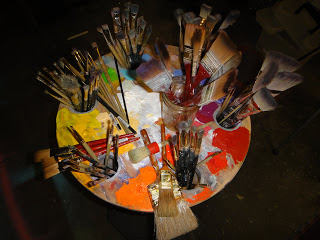8June 2011
On the Paintbrush. Part I
The paintbrush is my best friend. Over the last 15 years I have built an industrious relationship where we both know each other’s capabilities and use each other accordingly. Over the course of 3 posts, we are going to talk about the paintbrush. To begin, we will go over the basics of brush type, use, and care. Then we will go over each type of brush individually and what I use them for. There are many brushes available to the oil painter these days, and the type the artist uses is not just a personal choice, it is a commitment.
Regardless of the tools the oil painter comes to use in his discipline, the oil painter must first learn to control the paint brush. The paint brush is the single most recognized tool used to create works of art, but the artist must never be limited to its use solely for the application of oil paint. Although it is the classic tool of the oil painter, it must not be considered the most important. All tools as a matter of personal choice are simply a discipline to learn. The artist will simply know what tool is best used to achieve each intended concept. Within compositional oil painting, the intended concept of an oil painting supersedes personality and inevitably decides what tools should be used. Only the indented concept and communication of the work of art dictates what tools to use in its creation, as the artist and their work both know this and listen to their work’s whispers. Through the path of both self and external discovery, the oil painter will use other tools to create works of art. Later, as the oil painter matures, he will return to the use of the brush.
Let’s address the basics of the paint brush first. Paint brushes are made up of three basic parts: the head, the ferrule, and the handle. The head consists of the hairs or bristles of the brush. The head has three parts: the toe, the belly, and the heel. The shape and bristle quality of the head determines the nature of the stroke that it will make.
The ferrule is the metal cylinder, preferably seamless, that attaches the head to the handle. Ferrules with seams immediately should tell the artist that it is a poorly constructed brush, as seam type constructions are used to cut corners and save on production costs. I say a ferrule with a seam will fall apart quickly as its strength is in its wrap around of the handle and not in its crimp connecting the handle and bristles. Also a ferrule with a seam has way too much glue on the bristles to hold them together, and if they used a seam, you know they used cheap glue too! The use with oil solvents will quickly dissolve the cheap glue and your brush hairs will fall out. A ferrule holds the bristles in place, keeping their intended shape and keeping them connected to the brush. A seamless ferrule is only maintaining the shape of the brush.
The handle, typically made of wood, is self explanatory in its purpose and use. The professional oil painter should only use a long wooden handle, as the oil painter has more control over the paint. The short handled or plastic brush is for the hobbyist.
When it comes to bristle choice, neither natural hair or synthetic bristle paint brushes are better than the other, as there are benefits to using both bristle types. The outer casing of natural hair, the cuticle, is covered with tiny scales that help the bristles retain moisture. Natural hair brushes also have a hollow tube within each filament, called the medulla, that allows the hair to absorb moisture. These features make natural hair vastly more absorbent than synthetic hair, and therefore will always hold more color than its man-made counterpart. Natural hair paint brushes work with any medium and become more attuned to a single medium’s use. Synthetic bristle paint brushes are far more durable, making them longer-lasting, resistant to wearing out, and to being damaged by use with solvents and harsh paint. Synthetic hair bristles are easier to clean because they lack the ultra-absorbent qualities of natural bristles. As a result, synthetic brushes are better suited than natural brushes to use with oils due to their resiliency to the paint’s caustic effects.
As a preference to which bristle type is best to use, I say natural hair brushes. The professional oil painter should use the finest grade of natural hair paint brushes. Keep them clean and care for them, and the will outlast a synthetic brush. Also, natural hair is simply better because it is natural. There is a physical and metaphysical connection between the painter and his materials and tools. That connection is somehow stronger if the materials and tools are natural rather than synthetic.
There is a company that makes synthetic bristle brushes that are the closest thing to natural hair bristles that I have ever used. Princeton Art and Brush Company. They are so good that I have used their brushes for the last 10+ years. Princeton brushes are not the cheapest on the market, but they are very affordable.
The question of the expense of a paint brush is always in debate. I tell you now, cheap tools equal cheap results, and the oil painter that cannot tell the difference between a cheaply constructed paint brush and an expensive one, is not a professional, and subsequently their opinion on the matter is without merit.
Thanks or checking out my blog…
…more on the paintbrush coming soon.
